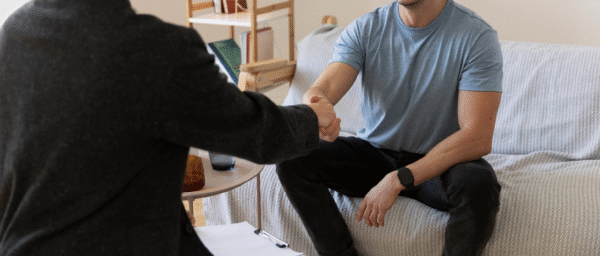As mental health recovery models evolve, more integrative approaches like yoga, breathwork, and somatic practice are becoming increasingly valued. For those navigating conditions such as anxiety, depression, or stress, these methods provide a powerful complement to traditional talking therapies.
But how are yoga and mental health linked?
We sat down with Kim Rearte de Santiago, one of Orchestrate Health’s expert yoga practitioners, to explore the relationship between body-based practices and mental health, as well as how reconnecting with the body can support lasting emotional resilience.
How Can Yoga Support Mental Health Recovery?
“Yoga and mental health are closely intertwined. Yoga supports mental health recovery by regulating the nervous system and restoring balance between the brain and body. Through both movement and breath, yoga can calm the autonomic nervous system and the hypothalamic-pituitary-adrenal (HPA) axis; the body’s core stress response systems.
Prolonged stress can cause dysfunction in these systems, contributing to mental health conditions like anxiety and depression. As Vanika Chawla noted, Yoga engages both top-down processes (intentional mind-to-body communication) and bottom-up processes (sensory signals from the body to the brain), encouraging a sense of safety and relaxation.
This bi-directional dialogue between mind and body creates a stronger foundation for emotional wellbeing — fostering calm, connection, and resilience.”
What Is the Connection Between Breathwork, the Nervous System, and Emotional Regulation?
“Breathwork is one of the most accessible tools for regulating the nervous system and supporting emotional balance. When we’re stressed, our breathing becomes shallow, rapid, and irregular, which can disrupt the balance of gases in the body and prolong feelings of anxiety.
Deliberate, controlled breathing helps to reverse this by activating the parasympathetic nervous system. This lowers heart rate and blood pressure, reduces stress hormones like cortisol, and cultivates a calmer, more grounded emotional state.
For many, breath-led approaches are a tangible way to influence the body’s stress response, aiding emotional regulation in daily life.”
Is Yoga Effective for People Who Live with Anxiety, or Find It Hard to ‘Switch Off’?
“Yoga is highly effective for people living with anxiety or those who struggle to “switch off.” The combination of breath, movement, and focused gaze works on multiple levels to reduce anxiety through:
- Proprioceptive input: Moving the body increases body awareness, helping to ground individuals in the present moment.
- Breathwork: Specific breathing patterns help regulate the nervous system.
- Eye movement: Shifting gaze during sequences can have effects, not dissimilar to EMDR therapy, which aids emotional processing.
Yoga also influences brain chemistry. It can increase levels of GABA (a neurotransmitter associated with calm) and reducing cortisol (the stress hormone).
Some evidence even suggests yoga may offer longer-lasting benefits for anxiety and depression compared to other relaxation techniques.”
How Can Movement and Somatic Practices Help When Talking Therapy Isn’t Enough?
“For some individuals, talking therapy alone may not fully address the physiological imprints of stress. Movement and somatic practices provide an embodied approach – helping the body process and release stress hormones like cortisol and adrenaline.
By engaging the body, these practices help regulate the nervous system, which in turn promotes emotional balance. Yoga, for example, directly impacts the hypothalamus and adrenal glands, reducing cortisol production and lowering the physiological drivers of anxiety and tension.
This integration of body and mind can create a more stable emotional state, especially in those for whom verbal processing isn’t sufficient.”
What Should Someone Look for in a Yoga Teacher to Support Their Mental Health?
“When seeking a yoga teacher to support mental health, it’s important to find someone who:
- Creates an empathetic, safe, and inclusive environment
- Offers personalised modifications based on individual needs
- Has a strong understanding of the nervous system and its connection to mental health
This ensures the practice remains adaptable, trauma-sensitive, and aligned with the unique requirements of each individual.
A well-informed teacher can guide students through practices that nurture both emotional and physiological resilience.”
Mental health recovery is rarely one-dimensional. As Kim highlights, the integration of yoga, breathwork, and somatic practices can offer a deeper, more embodied path to healing. This is especially true when paired with traditional therapies.
By reconnecting body and mind, these approaches can help foster not only resilience, but a renewed sense of self.





